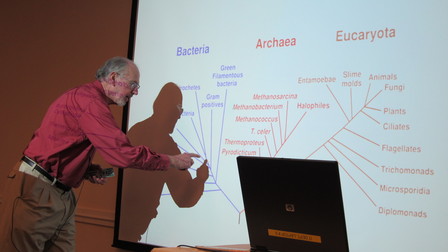If the universe has a grand design as Stephen Hawking suggests, Dietz Kessler recently described our part of it on Earth very well. Dr. Kessler retired to Carolina Meadows with his wife Jonny Prins last year. Dietz has had a long career doing research in and teaching cell biology at the University of Wisconsin, Haverford College and Colgate University. His topic “The Evolution of Cellular Life” presented at The Fairways Gallery was fascinating.
It is intriguing to know that life on Earth most likely got going 3 billion years ago. Just how and where atoms, molecules and water got together to form a cell is speculative. Wrapping a membrane around a group of cells to start evolution probably was waiting to happen.
Professor Kessler lectures on “The Evolution of Cellular Life.” Photo by Joe Mengel.
Some cells like ameba couldn’t wait. Neither could molecular structures such as bacteria. Our ancestral eukaryotes did. The eukaryotes (Greek for nucleus and cell) thought they could do a better job with a nucleus that had DNA; they did with spiraling helices of DNA. The intracellular mitochondria with their DNA helped too. From a single cell-cell algae 3 billion years ago, our world evolved into what it is today.
Dietz’s excellent PowerPoint images showed not only the internal anatomy of the cell but many aspects of Darwinian evolution that cellular life made possible.
He said how important the development in the 1700s and use of the microscope has been along with tissue stains to learn cell anatomy. Even more has been observed with the scanning electron microscope of the 20th century. The one-thousandth of a millimeter bacteria hiding beside a cell nucleus can now be seen.
Professor Kessler brought forward the origin and ongoing design of our inner world with a very intriguing presentation.

From resident Public Relations Committee member Dr. Jim Scatliff
